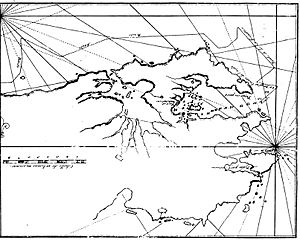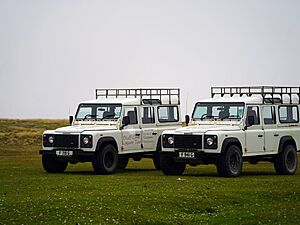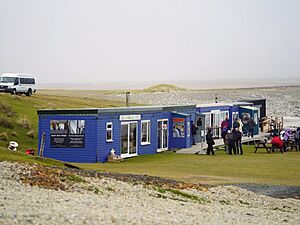Bluff Cove facts for kids
Bluff Cove is a small sea inlet and a settlement on the east coast of East Falkland in the Falkland Islands. It is also known as Spanish: Bahía Agradable or Hoya Fitzroy in Spanish. This area became well-known during the Falklands War in 1982. It was a site where British troops landed, and it was attacked by the Argentine Air Force. This event is sadly remembered as the Bluff Cove Disaster.
Bluff Cove is located near the highway that leads to RAF Mount Pleasant, a large air base. It overlooks a small, calm harbour.
On June 8, 1982, a sad event happened at Bluff Cove. Soldiers from the 1st Welsh Guards were on a ship called RFA Sir Galahad. They were waiting to go ashore when Argentine Skyhawk planes attacked their ship and another one, RFA Sir Tristram. Both ships were badly hit. Explosions and fires caused many injuries and deaths on Sir Galahad. Forty-eight people, including thirty-two Welsh Guards, were killed or badly hurt, with many suffering severe burns. After the war, the damaged Sir Galahad was sunk by the submarine HMS Onyx. It was declared a special place called a war grave. The Sir Tristram was fixed and returned to the United Kingdom.
Contents
What is the Climate Like at Bluff Cove?
The climate at Bluff Cove is a tundra climate. This means it has very cold average temperatures throughout the year. The temperatures can change a lot between seasons. It also gets a fairly small amount of rain or snow.
Exploring Bluff Cove: Penguins and More
Bluff Cove is now a private area owned by Hattie and Kevin Kilmartin, who bought the farm in 2005. It is a wonderful place to see wildlife. Many different types of penguins live here, including King Penguins and Gentoos. You can also spot other birds like Skua seabirds, Ruddy Headed Geese, and Falkland Steamer ducks.
Today, you can only visit Bluff Cove if you are on a special tour from a cruise ship. This means that people arriving in the Falkland Islands by other ways cannot visit this unique spot.
The Sea Cabbage Cafe: A Cozy Stop
At Bluff Cove, there is a lovely cafe called 'The Sea Cabbage Cafe'. It serves warm tea and delicious homemade treats like biscuits and cakes. It has a comfortable area where you can sit and relax. Every visitor gets a free tea or coffee and two baked goods.
The site also has a gift shop where you can buy souvenirs. There is also a small museum that shares the history of Bluff Cove.
Discovering History at the Bluff Cove Museum
The museum at Bluff Cove has many interesting displays. You can learn about penguins and the first settlers, called pioneers. It also shows what life is like for sheep farmers on the Falkland Islands and the history of Bluff Cove Farm. You can find out about the special qualities of Falkland wool and how it is spun into yarn for crafts.
The museum also explains the important role of horses on Falkland farms. You can learn about life in the "camp" (the countryside), which includes schooling, transport like air taxis and coastal ships, and how people communicate. There are exhibits on traditional music, how people used to cut peat for fuel, Sports Week, and doctor's visits to the countryside.
Other exhibits cover:
- Falkland Flavours: This section explores how people get food from the land. It includes raising farm animals and gathering wild foods like eggs, berries, and mushrooms.
- Charles Darwin's Visit: The famous scientist Charles Darwin rode with local cowboys called Gauchos across the farm in 1834. This was part of his journey around the world, which helped him develop his theory of evolution.
- The "Sugar Wreck": Learn about the Prussian ship Adeline, which wrecked at Bluff Cove in 1863. It was carrying "sugar loaves," which gave their name to nearby mountains.
- The 1982 War: This part focuses on the events of the 1982 war with Argentina, including the landings at Bluff Cove Farm. It also explains how the war led to democracy in Argentina and allowed the Falkland Islanders to choose their own future.
- Nature and Geology: Discover the wildlife in the lagoons, marine life, the geology of the islands, unique stone formations, and fossils.
- Island Industries: Learn about the history of fishing, sealing, and whaling in the Falkland Islands.
See also
 In Spanish: Bahía Agradable para niños
In Spanish: Bahía Agradable para niños






